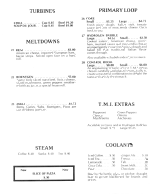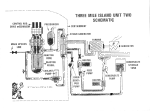| Home |
| Three Mile Island |
| Sequoyah Initial Fuel Load |
| X-ray |
| LANL Library |
| Email John |
| Created
05/10/07 Last update 02/21/2014
|
Nuke Stuff

I have a massive amount of nuclear materials to post in this
section as round tuits become available. A good deal of my time was
spent at Three Mile Island starting right after the accident in 1979.
Therefore there will be a lot of TMI-oriented stuff.
Just a few miles from Three Mile Island was a venerable institution called the TMI Inn. The Inn was a bar and restaurant that served mostly TMI employees. After the accident they adopted a positively nuclear atmosphere. In the center of the square bar was someone's interpretation of what the control board would look like. Flashing lights, gauges, switches and other stuff salvaged from the Island's boneyard. Unfortunately I don't have any photos of the bar. I DO, however, have their menu.
My favorite meals were either a Unit 1 or a Containment Building and some Steam with cream and sugar.
Unfortunately the last time I was in the area in 2005 the Inn had just closed. I talked to the building owner who said that it might re-open. Sure hope so. The Inn was a landmark of the area.
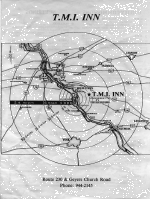
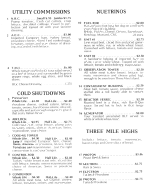
A photo of a Krytron tube as used in the detonator circuits of early atomic bombs pictured next to a piece of Trinitite, the melted sand under the Gadget at Trinity Site.
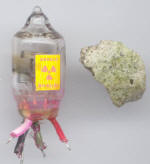
A couple of sources. The source on the left is a radium source and is out of an industrial ionization fire detector. The radium is deposited on the gold ribbon around the rim of the upturned part. The intense alpha radiation has "burned" the sticker backing paper where the source normally lays
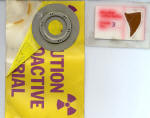
These photos are for the benefit of the radiophobes out there who fear anything radioactive. On the left is a photo of a container of Morton Salt Substitute. Salt substitute consists of potassium chloride instead of sodium chloride.
Potassium contains a percentage of the radioactive isotope K-40. Thus potassium and its compounds are radioactive. The photo on the right shows the contents of the container sitting on top of a pancake-type Geiger tube. As one can see from the meter, the stuff is radioactive.
The human body contains a significant amount of K-40 and with the proper instruments, is easily detected from the radiation it emits. Interestingly enough, vegetarians are significantly hotter than us meat-eaters because veggie oriented diets contain more potassium than a meat oriented diet.
One can correctly observe that we're all "hot stuff".
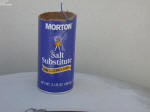
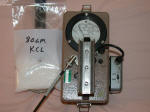
Here's another thing I like to show people. Humble wood ash from the fireplace. Yep, it's radioactive. About 250 counts per minute compared to (far right photo) about 35 counts per minute background. 35CPM is about typical for this area.
Where does the radioactive material come from? Some of it is K-40 but most of it is Cs-137 from fallout from atmospheric testing in the 50s. I know this because a) I have run wood ash on my gamma spectrometer and b) I've watched the activity decline by about half over my career. Cs-137 has a half-life of about 30 years.
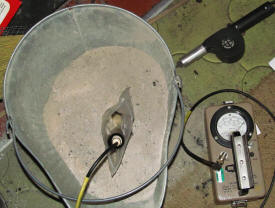
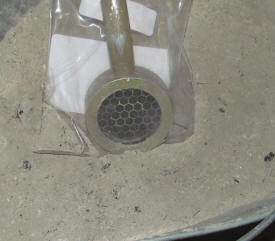
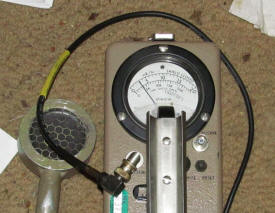
This is a photo of a "pancake" Geiger tube. It is the most commonly used tube in portable hand-held survey instruments such as the one in the photo above right. it consists of a metal housing containing an electrode that looks like an anti-aircraft artillery gun sight and a special fill gas.
The housing is covered by a Mylar Mica window so thin that it is specified in
terms of milligrams of weight per square cm. It is coated with aquadag
(colloidal graphite) to exclude light and make it conductive.
The Mica is so fragile that looking at it crooked can make it pop. it makes a sickening characteristic sound that every health-physics tech knows only too well. About $100 for that jewel.
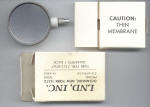
Rampant radiophobia has claimed another victim, the humble thorium-coated Coleman mantle. Thorium is used because it emits that beautiful greenish white light when heated by the lantern burner. Us nukes loved the mantles because they were hot enough to be used as check sources for survey instruments.
The radiophobes raised enough stink that Coleman took out the thorium and replaced it with a much inferior element. The "improved" mantles give off significantly less light. And of course, they're of no interest to us nukes.
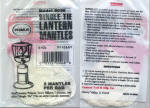
Century does make a non-thoriated mantle so one has to look carefully. Pictured at left is the good one. Two key indicators of goodness are the silly radioactive material warning and the "made in India" label. This mantle makes both campers and nukes happy!
This is a photo of the military issue Stocker and Yale quartz movement Tritium illuminated watch. The hour and minute hands and the dots around the dial on the hours contain tiny phosphor coated glass vials. The vials are filled with H3, tritium, the radioactive isotope of hydrogen. Thus the hands and dial glow continuously without requiring power.
Tritium is an ideal isotope, as the beta particle it emits is too weak to be dangerous or even to penetrate the tube but it is strong enough to strongly excite the phosphor and make it glow. About the only downside is the relatively short half-life of 12.3 years. In about 12 years the brightness of the capsules has reduced by half. In another 12 years, by half again.
I've owned the watch pictured for about 15 years. The brightness is way down from what it was in the beginning. Initially it emitted enough light that one could use it to find a keyhole in the dark.
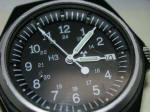

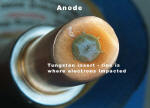
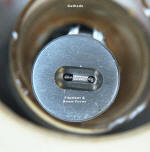
This is the Los Alamos National Lab's non-classified public-facing
library. Or what used to be.
The Clinton administration had a strong initiative to end needless
classification and to make declassified documentation available to the
public. "Libraries without walls" I think it was called.
LANL put up a huge collection of papers and reports, ranging from Manhattan
Project work to fairly current stuff.
Unfortunately when Shrub pissed his pants after 9/11, one thing he did was
order an end to all of this public access. Fortunately several folks had
realized the fragile nature of the access and had scraped the LANL site.
Individual articles can be accessed here:
www.sciencemadness.org/
The file to your right is the entire library compressed into one file for downloading. When you uncompress it, it will create the directory structure and HTML so you can browse the library with your web browser
Note that this is a Unix/Linux format compressed TAR. I chose that format because it is much more reliable for archives with thousands of files and gigabytes of data than zip files. Most any modern Windows unzipper can handle this format.
If yours won't then get the free 7-zip.
5.5 gigabytes.
MD5 sum -
f1ccbaf3589c1bafad27b767cc06cea9
Bytes - 5,475,085,033
